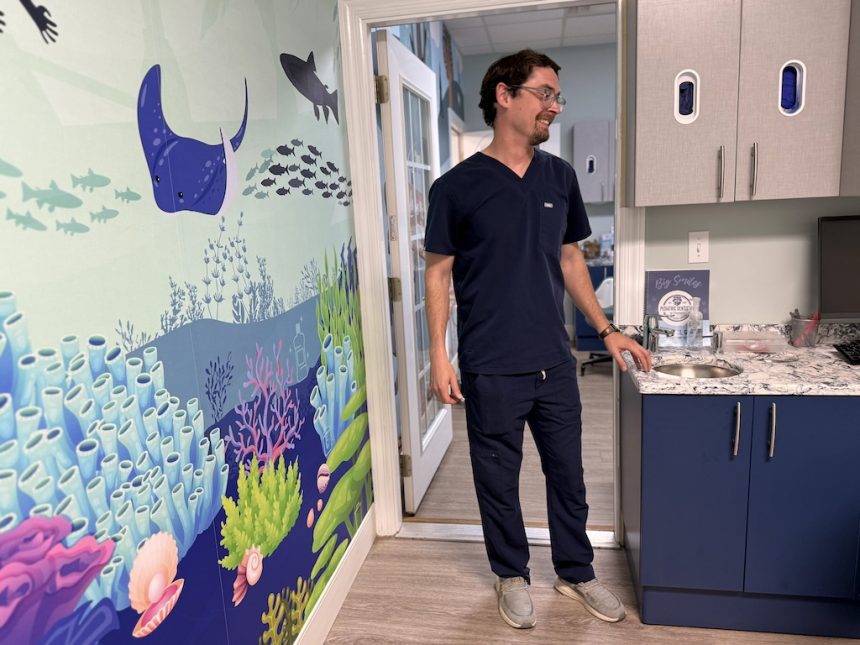Dr. Carson Cruise is a pediatric dentist in Florence, Ala. He has some patients whose families travel an hour or more to his clinic because he accepts Medicaid. Alabama’s low reimbursement rates have led some pediatric dentists to stop seeing patients who have coverage through the federal-state health insurance program. (Photo by Anna Claire Vollers/Stateline)
FLORENCE, Ala. — Sometimes, in a quiet moment between appointments, Dr. Carson Cruise runs the financial numbers through his head. They make a cold but compelling case: If he dropped all of the Medicaid patients from his small-town pediatric dental practice, he could make the same money while working far fewer hours.
Cruise, 36, owns a dental clinic in the picturesque Alabama town of Florence, home to the University of North Alabama, tucked into the rural northwest corner of the state. He and his wife have two little boys, ages 3 and 5. They sold their small family farm recently because it became too difficult to keep up with it and his practice and still have time for their family.
All of his patients are children. About half of them have their dental care covered by Medicaid, the joint federal-state health insurance program for people with low incomes. They come to his clinic from across the region, he says, and some parents drive from rural communities an hour away. He’s got a waitlist four or five months long.
“I have great relationships with a lot of these families I’ve been seeing for years,” he said. “I don’t want to leave them hanging, but it’s getting to a point where it’s really difficult to keep working at the pace we’re working and seeing the volume that we’re seeing.”
Even though more than half of Alabama children are enrolled in Medicaid, Cruise said he is the only board-certified pediatric dentist in the area who still accepts it.
Alabama is a vivid example of a national problem. Most state Medicaid programs pay dentists far less than private insurers do for the same services. As a result, not enough dentists are willing to take Medicaid patients, leaving low-income families in Alabama and many other states with limited options for providers and longer wait times when they find one.
Alabama has fewer dentists per capita than any other state except Arkansas, according to the American Dental Association. A handful of Alabama counties lack any dentist at all, while other areas — including parts of Lauderdale County, where Cruise’s clinic is located — are considered dental deserts, places where patients have to drive at least half an hour to reach a clinic.
The problem is likely to get worse: In several counties, more than half of dentists are 60 or older, while nearly half have no dentists under age 40.
States have flexibility in how they structure their Medicaid programs, including in how much they reimburse providers. Alabama Medicaid reimburses dentists about 46% of what they charge, on average, for their services.
The state pays so little for some procedures, Cruise said, that dentists lose money by providing them. Some dentists decide that treating Medicaid patients just isn’t worth it. That helps explain why, even though Alabama children get cavities at rates similar to children nationwide, they are less likely to be treated for them.
Many of those kids’ parents are also going without care. Alabama is the only state where the Medicaid program doesn’t cover any dental services for adults, with the lone exception being women who temporarily qualify for Medicaid due to pregnancy.
Those gaps in care aren’t a geographical fluke, but the result of political choices, says Zachary Schulz, a public health historian who teaches at Auburn University and who compiled the state health department’s most recent report on oral health.
“The reason we have the health system we do is because of the policies that dictate it has to be that way,” he said.
I love helping these kids. I also have two kids of my own to take care of, and I can’t subsidize this care for the state of Alabama.
– Dr. Carson Cruise, Alabama pediatric dentist
If Cruise only accepted patients with private insurance or who could pay out of pocket, he’d make far more per patient. That would allow him to cut his patient volume in half and reduce his staff and overhead costs, he said. He could work fewer days a week and potentially take home a bigger salary for himself.
That hard-eyed calculus is at odds with the cheerful murals in the exam rooms at his clinic and the vintage Disney posters lining the hallway. It’s at odds with his own conscience.
“I love helping these kids,” he said. “I also have two kids of my own to take care of, and I can’t subsidize this care for the state of Alabama.”
A dental silo
When it comes to health insurance, teeth and gums have been separated from the other parts of the body, with inferior coverage and higher out-of-pocket costs.
Medicaid coverage of dental care varies from state to state but tends to be limited. Only about half of states and the District of Columbia cover a wide range of dental services for adults, according to the National Academy for State Health Policy. The others offer limited coverage or only cover emergency procedures. Medicare, the federal health insurance for people over 65, doesn’t pay for most dental care.
Even with private plans, consumers often bear more of the cost of their dental care than they do with medical insurance. While most dental plans cover 100% of preventive services such as teeth cleanings, they tend to cover only about half the cost of major procedures, according to the National Association of Dental Plans.
Insurers may consider dental care to be less critical than other medical care, but the lack of it can have serious, even life-threatening, consequences.
Bad oral health has been linked to heart disease, stroke, pregnancy and birth complications, dementia and a number of cancers. It can impact a person’s mental health, or even their ability to get a job, said Schulz.
As part of a research project involving Alabamians leaving prison and trying to reenter the workforce, he found that many have a hard time landing job interviews not just because of the stigma of being formerly incarcerated, but because of something as simple as not having all of their teeth.
“They won’t get the job because they look poor, or like they don’t take care of themselves,” he said. “We view a healthy mouth as a sign of money.”
‘Having to triage kids’
Recently, Cruise saw a young patient who had cavities in all 20 baby teeth. Several of those teeth were infected and abscessed.
For a patient who’s 5 or 6 years old and requires complex care, an office visit won’t work. Extensive dental work done under anesthesia has to take place in a hospital.
But Cruise’s waitlist for hospital procedures is about six months long. Sometimes, parents call begging for help with a child’s tooth pain or infection weeks or months before their scheduled procedure. Often, all he can do is call in a prescription for antibiotics to try to keep the infection in check before he operates.
“It gets to a point where you feel like you’re having to triage kids and do Third World care in a First World country,” Cruise said. He keeps a list of kids who have pain or infection.
“Those are the ones we try to triage and move to the front of the line. There’s just not enough availability to treat all of these kids efficiently.”
Dr. Carson Cruise, a pediatric dentist, consults with dental assistant Aisha Roman at his office. Roman is bilingual and helps translate for Spanish-speaking patients and their families. (Photo by Anna Claire Vollers/Stateline)
And yet, he counts it as a win that he’s able to treat patients in the hospital at all. Until recently, many Alabama hospitals had stopped accepting Medicaid-covered pediatric dental patients because the state’s reimbursement rate didn’t begin to cover the costs of an operating room, nurses, anesthesia or equipment.
But after dentists and other groups advocated to get the state’s rate increased, a nearby hospital granted Cruise operating room privileges and he was able to start seeing patients locally, instead of referring them two hours south to a hospital in Birmingham, where the waitlist could be a year or more. That distance had posed a problem for patients without reliable transportation.
“It shows that if we try to fix these things, we can fix them,” Cruise said. “But at the end of the day, it takes money.”
Untreated
Nearly a quarter of Alabama third graders had untreated tooth decay in 2022, according to the most recent state report, a higher rate than the national average. But the overall numbers mask a demographic divide: Children attending lower-income schools were significantly more likely to have cavities. Black and Hispanic children were more likely to have tooth decay than white children.
Dr. Stephen Mitchell, a professor at the state’s only dental school, in the University of Alabama at Birmingham, said the Alabama Medicaid program does a good job of making Medicaid coverage available to children and youth under age 21, at least when it comes to eligibility rules.
But reimbursement rates are another story, though Mitchell believes state Medicaid officials are doing what they can with the limited money they have. This year, Alabama lawmakers approved a 19% increase for Medicaid, and the state has raised dental reimbursement rates three times since 2021, and still the payments are too low for many dentists to provide care to Medicaid patients.
“We’re not the wealthiest state,” he said. “We’ve got to be smart. A dollar of prevention saves a hundred dollars in treatment.”
Better-paying neighbors
Cruise has a friend who’s a pediatric dentist and works a little more than an hour’s drive from his clinic, over the state line in Mississippi. He said she is paid about 25% more than he is for the same procedures.
For a child’s tooth extraction, for example, Alabama Medicaid reimburses dentists $64. Mississippi Medicaid reimburses about $83 for the same extraction.
Alabama Medicaid just began giving dentists an extra $10 per patient per visit for dental care. It’s appreciated, Cruise said, but he hopes the legislature will do more.
No one is sure how President Donald Trump’s broad tax and spending law, which cuts more than $1 trillion from Medicaid over the next decade, will affect Alabama’s already strapped Medicaid program.
But a further reduction in state reimbursement would likely push Cruise to take the step he has long dreaded: refusing to accept Medicaid patients.
“The last thing we want at this point is a budget cut, because we’re already doing some things at a break-even or even at a loss,” he said. “If we cut that even more, it’s going to turn what’s a very tight profit margin into a negative.
“Most of us have a heart for helping these kids and we’ll do it. But you’ve got to move the needle.”
Stateline reporter Anna Claire Vollers can be reached at avollers@stateline.org.








